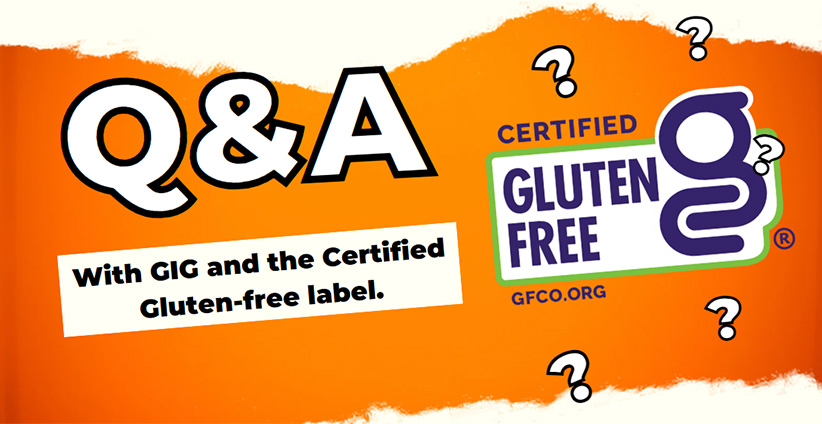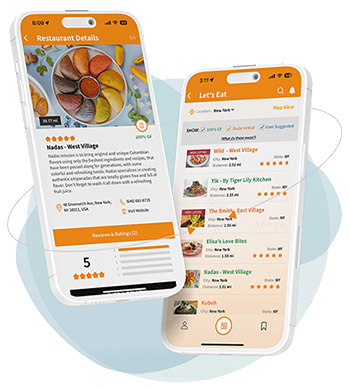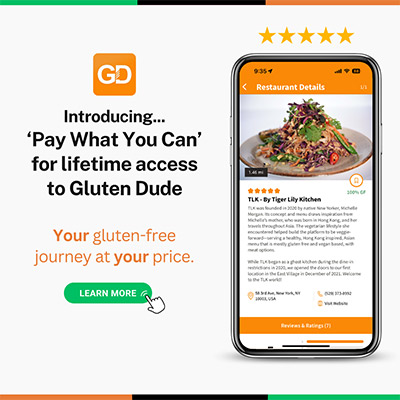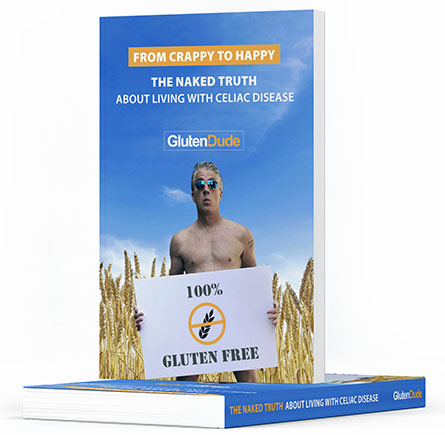Before I kick off this long but very important post, I want to give a major shout out to my father-in-law Fred, who passed away in the early hours yesterday. He will be remembered as a loving husband, a wonderful father, a doting grandfather, a good friend and an overall kind and gentle soul. While he may have driven an extra 10 miles to save a buck (and I say that with love…he was an accountant), he’d give the shirt off his back if you asked for it. I am thankful for his generosity and his friendship the past 32 years. And of course so grateful for bringing Mrs. Dude into this world and raising an amazing human being. RIP Fred…you will be greatly missed.
Ok…on to the task at hand. If you have not read the first part of this post, please read it now and then come on back so you can get a clearer picture of what I’m talking about. But here’s a quick summary:
Aussie Bites are mini-muffins that (up until last week) carried the Certified Gluten-free label from the GFCO. After multiple complaints of people getting sick, the Aussie Bites were tested multiple times and came back WAY OVER the legal limit of 20ppm gluten. Note that the Aussie Bites include oats, though it’s not been confirmed that what the issue was.
So naturally, I had some questions and concerns about HOW they got certified, so I reached out to the Gluten Intolerance Group (the company behind the GFCO label), sent them a link to the post I wrote and to their credit, they were open and thorough in their response (though I still have my concerns). Here’s how the conversation went down.
GD: Hi folks. Gluten Dude here. I wrote an article today on the Aussie Bites and the Certified GF label. I had some questions, which you can find toward the bottom of the article. I am hopeful you can answer them so the community can continue to have faith in your service. And perhaps jump on my GD Facebook page, as people are asking good questions there too. Thanks.
1. How did Aussie Bites get the label in the first place?
Best Express Foods did earn certification for Aussie Bites, and other products, by meeting and maintaining GFCO’s requirements for certification starting in October 2022. A recent consumer complaint resulted in an inquiry that showed testing of multiple lots at gluten levels ranging from below GFCO’s standards, to well above FDA standards. Similar results were also reported by Gluten Free Watchdog. At our direction, the company contacted the FDA and immediately began pulling products (affected lots) from Costco. However, based on a full investigation demonstrating that Aussie Bites was no longer meeting the requirements, we rescinded certification and notified the public.
2. Should any non-dedicated facility ever get a certified label from GFCO?
We have had tremendous success in certifying products from both dedicated and mixed-use facilities. Issues can arise in either and our standard requirements mitigate many of those risks. GFCO’s requirements for proper cleaning and testing protocols ensure safe production in mixed-used facilities.
3. Should a company using SHARED EQUIPMENT ever get the label?
GFCO’s requirements for proper cleaning and testing protocols ensure safe production in mixed-used facilities, including shared lines. When there is a shared line, a thorough cleaning and multiple swab tests must indicate no presence of gluten prior to the production of GFCO products.
4. What steps is the GFCO taking to ensure this doesn’t happen again?
Great question. Anytime there is an issue with a GFCO-certified product, we investigate the situation and develop corrective actions for both the manufacturer and internally at GFCO. Food manufacturing is intricate, complicated, and ever-evolving, so there is always room for improvement. In the past three years, 87 recalls were prevented because the GFCO standards worked in every situation – this is information that the public wouldn’t be aware of, because the problems were corrected BEFORE products made it to market, though not without cost to the manufacturer. It’s the commitment GFCO and our clients make to ensure gluten-free food is safe.
Other points of clarification/confirmation:
- YES – a shared equipment statement is voluntary for consumers, but the disclosure to GFCO is mandatory. When in effect, it is a risk that we mitigate by enforcing strict cleaning and testing protocols.
- YES – we’ve also heard about previous concerns on Aussie Bites, GFCO has investigated the safety of these products in the past and had consistently confirmed the product tested below GFCO’s 10ppm standard, until recently.
- YES – GFCO is a program of the non-profit Gluten Intolerance Group, celebrating 50 years (this year) of service to the gluten-free community. We work hard to ensure the safety of over 65,000 gluten-free products. Can an issue still arise? The chances are quite literally 1 in a million production runs, but when/if it does, we are quick to alert the community. The safety of the gluten-free community is our #1 priority – we are gluten-free, just like you.
- Yes – you have outlined that process on “HOW a company gets the GF Certification label”…the simplified explanation. What is not explained in detail here is the thorough evaluation of over 100,000 ingredients every year, the rejections that are issued every day, the depth of the onsite audits, the corrective actions that must be implemented, the review of testing submissions, etc. Typically, manufacturers seeking GFCO-certification want to get gluten-free right and invest considerable resources in meeting our requirements, 99.9% of the time, it works. We are proud of our track record.
- Yes – our full pricing schedule is publicly available. We are proud to base our cost structure on the size of the business (with very low fees for small businesses) and risk level (the greater the risk, the more work to ensure compliance). As a non-profit, we aim to keep our margins low, with proceeds benefiting our education, support, and food insecurity efforts. The cost to operate this program with integrity is high due to the continual surveillance and inspection costs along with normal operating costs like our own staff, etc. Being a non-profit does not mean we do not make money. It means the money we make goes to serve our community directly, which we document in our annual IRS audits.
Once again, thanks for helping us spread the word about Aussie Bites and allowing us to contribute answers. If you have additional questions or concerns, feel free to reach out to me at any time.
Naturally, I had a few follow up questions, as follows.
GD: Hi Jeanne…thanks for the response. A few follow up questions if you don’t mind:
1. A few people say they are still seeing Aussie Bites with the GF label on the shelves. Whose responsibility is it to make sure they ALL get removed?
2. I understand about a shared facility being able to keep us safe, but I’m surprised GFCO would provide a label for companies that use shared equipment. You are counting on them to clean the equipment thoroughly after every single use. That puts a lot of faith in a company who I’m sure, like most big companies, puts the focus on speed over safety.
3. Did they communicate with you explaining HOW the item isn’t gluten free anymore. Did they change ingredients? Processes? Is it the oats?
4. Can you explain your pricing sheet? Not the actual prices but how you determine if a company is Low Risk, Medium Risk or High Risk. And if a company is high risk, it is worth giving them the certification?
Many thanks in advance for your open communication.
Following are their responses, with some Dude Note reactions thrown in.
1. A few people say they are still seeing Aussie Bites with the GF label on the shelves. Whose responsibility is it to make sure they ALL get removed?
We can confirm that the following lots Aussie Bites, tested by GFCO and Gluten Free Watchdog, have been removed from store shelves at Costco: BEF2 113 04 24 with a Best By 08/01/24 and BEF2 059 02 24, Best By 06/16/24.
GFCO has subsequently found additional lots testing above the FDA threshold and strictly advises the community to not eat this product.
The manufacturer has been instructed to remove the mark from all products in production and advised that any products currently in-market bearing the GFCO mark must contain no more than 10ppm of gluten, and they are responsible for ensuring that. The company, and additional sources, have made the FDA aware of the situation, but a recall has not yet been issued. As GFCO cannot force the FDA to act, we have invested our efforts in amplifying the message to the community and via the media, in both the US and Canada.
Dude Note: How would Aussie Bites know which products currently in-market bearing the GFCO label would be under 10ppm? They are obviously not doing internal testing or the products never would have made it to the shelves.
Simply put, shared lines are rare. In instances where shared lines are used, we do not go on faith…companies with GFCO-certified products are contractually obligated to follow our requirements and we verify their compliance with their cleaning and testing protocols.
As for speed over safety…In our 19 years of certifying products as gluten-free, we have found that the vast majority of companies who choose to seek certification… are the ones that focus on safety first. Certification requires an investment in operations and ongoing commitment to safety – and is strictly optional for companies.
Dude Note: I understand the label is optional but if a company wants to compete in the GF marketplace, I’d say it’s near mandatory. I have had multiple companies reach out to me over the years with their frustration and cost over ‘needing’ the label.
3. Did they communicate with you explaining HOW the item isn’t gluten free anymore. Did they change ingredients? Processes? Is it the oats?
No. Our investigation resulted in a withdrawal of certification for not complying with our standard requirements.
Dude Note: That’s a bummer. I would think the HOW would be really important for the GF community to know.
4. Can you explain your pricing sheet? Not the actual prices but how you determine if a company is Low Risk, Medium Risk or High Risk. And if a company is high risk, it is worth giving them the certification?
Yes! For that we take into consideration the risk of the ingredients both used in the gluten-free products they are seeking certification for, as well as the other ingredients in the facility. Additionally, we look at whether it is a dedicated gf facility or mixed-use. Also, whether there is a dedicated space for gluten-free or if the processing shares lines/storage, etc. Finally, we look at the size of the company as a higher output of product does mean a higher risk of potential issues due to the volume of ingredients through the facility. Obviously, there are a lot of intricacies that also go into assessing risk, but this is the basic outline for general understanding:
Risk Level 1: These ingredients have no perceived risk for use in gluten-free foods, like: vegetable oil.
Risk Level 2: These ingredients have a low risk for use in gluten-free foods, like: tapioca starch.
Risk Level 3: These ingredients have a moderate risk for gluten contamination because they commonly share some part of the supply chain with gluten, like: rice flour.
Risk Level 4: These ingredients have a high risk for gluten contamination because they share one or more steps of the supply chain with gluten-containing grains, like: oats.
Is it worth giving high-risk ingredients certification?
We believe these are THE MOST IMPORTANT products to get certified. Many of the foods that we all enjoy contain ingredients grown on farms where agricultural comingling is inevitable. Certification of these products ensures multiple safety steps at multiple stages throughout the supply chain. As gluten-free consumers ourselves, we would not eat a product containing high-risk ingredients unless it was GFCO-certified.
I hope this provides some clarity.
Dude Note: Well…it does, and it doesn’t. GIG uses the word “ensures” a lot, which connotates a guarantee. I will say this until I’m blue in the face, any product that is produced in a shared facility and especially a shared line cannot be guaranteed to be safe. “Can” they be safe? Of course. But “will” they be safe? We can only hope so.
Look…nothing is perfect and all we can hope is that every person/company that represents or targets the celiac community has our health as their absolute top priority. But we’ve already seen this to not be the case (i.e. the CDF putting their label on every f***ing box of Cheerios, apps promoting non-100% GF restaurants as ‘celiac friendly’, influencers (blech) taking money to promote unsafe products, etc.)
We live in a profit-driven world and we have to have faith that everyone, yes even non-profits, have our back.
Do they? Share your thoughts.








Going off of this have you seen this new article. All foods bearing a certified label. Scary, horrifying, and unsettling to say the least.
https://www.momsacrossamerica.com/gluten_free_food_test_results?fbclid=IwZXh0bgNhZW0CMTEAAR1-UiyxJVeZAo7mfF40ZeWtmxUaNOQsgWGbbE2pHvPODm3QJk4P9SO4p58_aem_AcYEv1aqlsctqQkjZhRlBZBAUSZwTH9t4WDqivhqfLkuASquFqKmOIg1V4kp-oY7gtM-EoEFXtjIrufe9C4JtNwY
Wow! Thank you for sharing this! I don’t even know what to think at this point after reading that. I wish I could see all of the products we eat tested and the results.
Well THAT was eye opening. I reached out to them for more info. Thanks for sharing.
Hi. “Mom’s Across America” is a radical, anti-vaccine fundamentalist organization that promotes dangerous myths such as that autism and food allergies can be cured with organic foods. They are not worth listening to on this or any issue.
Thanks for letting me know Alf. I did ask them how they tested the foods the came over 20ppm. No response yet.
Thank you for sharing this, Melissa. The high level of pesticides and chemicals in all of our food needs to be stopped. I am disheartened to read the results on so many of my favorite products. It is interesting to me that some of the Schar products tested high on the list when that is a European based company, and the EU seemingly has better standards around this.
The simple mills have made me sick on a number of occasions so I very much believe these results
[Diagnosed celiac disease as adult in 2020 & gluten-free diet since]
I will still use the GFCO label. It is an extremely helpful indicator for me, as all other non-profits or associations who issue certified gluten-free labels have led to me being sickened – more than once – by the products at one time or another. I still have the choice not to purchase the GFCO-labeled products because I am not comfortable with the potential risk; I have done it before and probably will in the future. The GFCO label also makes it easier on my family to buy food stuffs when they cannot consult me in the moment: it lowers the likelihood of returning to the grocer for a refund and buying the same(-ish) food item from a different producer.
Understood Mea.
When I see GIG I know not to trust. I got extremely sick from their suggested restaurant. 1 year and 40 pounds gone I finally recovered. It all sounds good but is really just a ( well I won’t finish that thought). Learned my lesson, I do all my research on every product. I really only eat real foods and only from my kitchen. Just my experience though. We all have our different ways based on experiences.
Indeed we do.
I recently read and understand that a new variety of wheat was introduced in the 1970’s that is easier to grow and more productive and some dude won a Nobel prize for it and it helped starving masses. But it was way higher in gluten and has possibly triggered a gluten allergy in different masses.
I also understand that General Mills et al understand this, but the profit motive keeps them on track to produce what I consider poison.
What can we do? I worry for my kids and grandkids or my late onset celiac who still eat this poison.
Companies will always do what is better for their bottom line.
I have experience to add to this discussion that most people probably wouldn’t think about. For the past 20 years I’ve worked in printing, including labels for health and beauty products, and packages for candy/food. Printing companies are third-parties that are contracted to print the designs supplied by other companies. The designers/prepress workers at printing companies will be requested to add certification logos (such as FSC for sustainably sourced paper), or just to print nutrition and ingredient info that we have no knowledge of, or any involvement with producing.
In the case of paper, it’s the job of buyers at the print company to ensure they buy the correct paper that matches the printed claim, and then trust that the paper manufacturer (another company) is producing that paper in a way that matches the claim. Then it’s the responsibility of the printing department to make sure they use that correct paper for the job that matches the claim that is printed.
In the case of food, it’s entirely up to the company providing the packaging designs (which could be a third-party design house working with a corporate manufacturer) to ensure that they are correct, accurate, and comply with third-party certification or government regulations. Once printed, the labels/packages go to a filler, which could be another third party company that is contracted. The printing and packaging of manufactured items is entirely different from the items contained within.
So a company we think of as a “manufacturer” might have hired other companies for every step to:
1. Make the packaging/label design
2. Print the packaging/label
3. Make the physical product
4. Fill/Package/Label the product
5. Ship and distribute the product
6. Sell the product
Having seen this from my work, and I understand how important it is for good management to see that multiple departments all do the correct thing at each step of the process. Because each step I listed has many sub-steps where many different people contribute to the production.
So I was VERY interested to read how one certification organization monitors, audits, and enforces the use of its label. The costs the GFCO charges seem very low to me, really surprisingly low. It’s virtually nothing to a large nationwide producer. For smaller ones, I wonder if they would contract with smaller production outfits that might service many food companies. In that case, the production site’s certification cost would be split among many.
It’s all very interesting to me, and hopefully my perspective adds some points to think about if anyone reads all this!
Appreciate this post and seeing it from a different angle. Thank Daniel.
GFCO is probably the label I see the most and I trust it the most. I appreciate their honest answers. There’s only so much they can do. They seem to be a driver of good behavior based on making it more expensive to use higher risk methods and ingredients. Which is fine by me.
There’s human nature to deal with too. If they came on all “thou shalt do X or thou shalt suffer the consequences” then they would get people gaming the system and trying to evade. It’s more clever to have a “more expensive” way which goes through oats, and a “less expensive” way which goes through chickpeas. People panic about chickpeas, but idk, I’m really sensitive to flavors and I don’t detect beany flavors. But then again, I love hummus. Not everyone does.
I’m disheartened too by the part… “I would think the HOW would be really important for the GF community to know.”
We never got an answer either from Canyon Bakery about what went wrong with the bread exactly, other than “a supplier” problem. Pretty vague.
There are quite a few products “cowboying it” and not getting any certification at all, I’m noticing. Yet when their website is looked at, they’re clearly taking Celiac Disease seriously. Labrada protein shakes for instance.
I agree Angelica. Though I do wonder if there is only ‘so much they can do’, the label shouldn’t say Certified GF.
Thank you for always giving us the straight skinny and prayers to y’all for Fred’s passing.
Much appreciated Sharon.